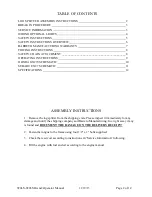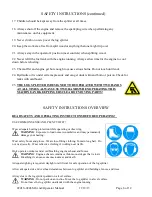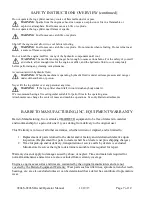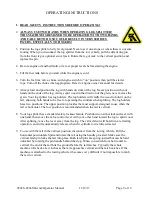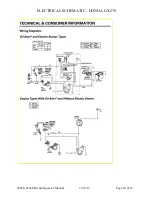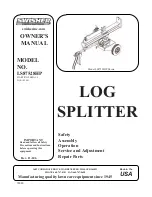
920LS-922LS Owner/Operator Manual
11/19/13
Page 9 of 12
OPERATING INSTRUCTIONS
1.
READ SAFETY INSTRUCTIONS BEFORE OPERATING!
2.
ALWAYS USE TWO HANDS WHEN OPERATING LOG SPLITTER!
THIS MACHINE IS DESIGNED TO BE OPERATED WITH TWO HANDS
AND FAILURE TO DO SO COULD RESULT IN VERY SERIOUS
INJURY, ESPECIALLY TO FINGERS!
3. Position the log splitter on dry level ground. Never use it on a slope or where there is not sure
footing. When you disconnect the log splitter from the tow vehicle, pull the detent ring pin
from the front leg or optional swivel jack. Rotate the leg or jack to the vertical position and
replace the pin.
4. Be sure engine oil and hydraulic oil are at proper levels before starting the engine.
5. Fill the fuel tank before you start while the engine is cold.
6. Turn the fuel line valve, choke, and engine switch to “on” position, then pull the starter
rope. Turn off the choke when appropriate. Refer to engine owner’s manual for details.
7. Always load and position the log with hands on sides of the log. Never position with your
hands on the ends of the log. Always split wood in the direction of the grain, never across the
grain. Your log splitter has log holders. The log holders will cradle the wood to hold it on the
rail, allowing both hands to be free for operating the controls when splitting. The log holders
have two positions. The upper position provides the most support, designed to use when the
rail is horizontal. The low position is recommended when the rail is vertical.
8. Your log splitter has a standard safety lockout feature. Push down on either lockout lever with
one hand, then move the valve control lever with your other hand toward the log to split wood.
After splitting, move the lever away from the log. The valve detent will hold it in a retracting
operation, and will automatically release when the cylinder rod is fully retracted.
9. To use with the rail in the vertical position, disconnect from the towing vehicle. Pull the
horizontal position latch pin and rotate the rail using the handle provided. Make sure the
vertical latch pin locks the rail into place. Both latch pins are spring-loaded but can be held
unlocked by rotating the pin handle behind the stop. When you switch from horizontal to
vertical, the end of the rail hits the ground before the rail latches. Typically the whole
machine rolls back a few inches as the rail approaches vertical and the latch catches. If the
machine is attached to the towing vehicle it becomes very difficult if not impossible to latch
the rail to vertical.


